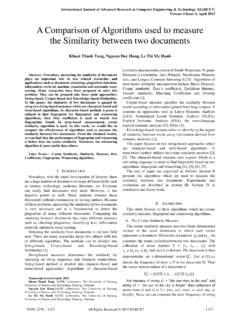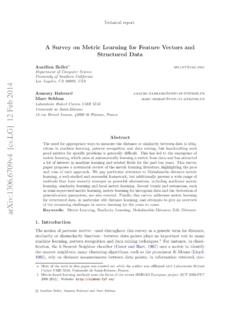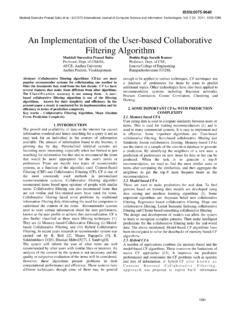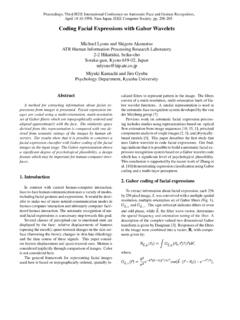Transcription of White Paper: Video Compression for CCTV
1 Bosch Security Systems paper : Video Compression for CCTVOver the last few years, the analog Video signal from surveillance cameras has been increasingly digitized for archivingand transmission purposes. This article provides an overview of the methods currently available for digitization and datacompression, and considers the advantages and disadvantages of their use in cctv digital Video signal provides many advantages over analog signals: digital signals can be processed using computers orsignal processors and transmitted via digital networks. Transmission via existing (phone) lines and non-wearing recordingon hard disks are promoting the trend toward digital Video signals. Because a digitized Video signal has a very high datatransfer rate of 216 Mbit/s (according to CCIR 601), suitable data Compression methods must be used for processing andtransmission. Imagine, an entire DVD, capable of storing about 8 GB of data, would store less than five minutes of algorithms have been developed for various applications at an international level.
2 These algorithms havebeen tested and standardized by several organizations. The methods are alternatives to a certain extent, because theywere developed with different aims and are tailored to specific applications. Overall, the range of available standardizedvideo Compression methods covers practically all (1 IPS)Standard( - IPS)Full Motion(30 IPS)Bitrate /MbpsFramerateM-JPEGMPEG-4 MPEG-2 Wavelet0482610 High(15 IPS)MPEG-4 Sp re adMPEG-2 SpreadM-JPEG SpreadWave let Sp readComparison of the Performance of Different Video CompressionAlgorithms at Various FrameratesSource: Dr Bob Banerjee and Justin Lott, Bosch Security Systems, 2005 Some Compression algorithms permit a degree of variation within the standard to meet technology constraints. The mostcommon Video Compression methods use the statistical similarity of adjacent pixels. The image is converted to afrequency space block by block using the DCT (Discrete Cosine Transformation).
3 In Video coding, it is also possible to usethe strong time correlation of consecutive frames the objects shown are usually static or move in a more or lessconstant manner. If the difference between the images is calculated with motion estimation, it is only necessary to transferthe changes from frame to Security Systems Comparison Table of Compression AlgorithmsCompressionStrengthsWeaknessId eal ApplicationsJPEGAn industry standard, meaning that acamera they can generate JPEGs is likely tobe viewable by the largest range of videomanagement noticeable degradation at with very active easy to implement trick-play(play/ pause /rewind / forward wind/ stepfwd/rev etc.)Under high compressionratios the Video at compressingquiet-moderate of 8 Mbps arevery common, whichmakes it hard to transmitbut almost unaffordable tostoreStoring photographs or snapshotsfrom a videoVery low framrate cctv (<5 IPS) butwith high scene-activity Bosch s DiBos v7 Hybrid as JPEG, except the JPEG imagesare payed in rapid per per JPEG, but particularly commonin cctv due to its s popularity has caused the cctv market to accept low framerates ( ) as the norm.
4 The same as MPEG, butoptimized for 2-way low latencytransmission via 128 kbps (2 ISDN B channels) imagequality and image refresh rate performance whenhigher bandwidths conferencing of its large range ofbandwidth (from 64 to 1920kbit/s), it can be used in almost allother media (LAN, WAN) for low data transfer rates(below 64 kbps).Low performance whenhigher bandwidths via GSM mobilenetwork, modem and analogtelephone quality Video on extremely cheap quality is consideredby many as anunreasonable cost Video CDs (VCDs).The audio component (so-calledAudio Layer 3) of MPEG-1 hasbecome known as best quality Video modern cctv systems can ,typically Mbps quality Video , DVDs, LANTV, high-fidelity stereo Bosch s VideoJet 8000 and VIP1000 encoder and (Part 2)Very efficient at high framerates when thedifference between subsequent is typically 100-1,000 kbps efficiency at very lowframerates or extremelyhigh scene the bitrate is limitedthe Video artifacts arespeckling and a , especially when a highframerate is used, or when themajority of scene activity is low Bosch s VIP X1 and VIP XDencoder and Bosch s DiBos v8 Hybrid Security Systems ( MPEG-4 Part 10)
5 Promising broadcast-oriented technologythat is more efficient than current MPEG-4 Part 2 High power processinghardware required andhigher lag-timesNext generation MPEG-4, to be usedon HD DVDs, HDTV and s new XBOX 360 gamesconsole is expected to use HD DVD,offering 15 GB looks great even under highcompression because the human eyeaccepts a fuzzy picture more than extremecompression the videobecomes fuzzy anddiffused, not betweendiffererent Bosch s Compression ratios for images thathave large areas of repetition, sky,water to compress,requiring betweendiffererent photographic Compression , a photo on a smart-cardidentity card, where Compression timeis summarizing the pros and cons of each of the mainstream Compression algorithmsStorage Space vs. Transmission BandwidthThere are two primary reasons to compress Video : To reduce the amount of of storage space required to store the Video so that more hours of Video can be storedon various media including hard disk drives, solid state memory, CDs and DVDs plus many more.
6 Storage istypically measured in bytes (B), Kilobytes (kB), Megabytes (MB), Gigabytes (GB) and Terabytes (TB). To reduce the bandwidth required to transmit the Video across digital connections including local and wide-area IPnetworks, the Internet, SCSI connections and USB connections plus many more. Bandwidth is typically measuredin bits per seond (bps or baud), Kilobits per second (kbps), Megabits per second (Mbps) and Gigabits per second(Gbps).In the first generation digital systems DVRs replaced VCRs, and so the market became familiar with units that reflectstorage needs, kB and MB etc. However in the second generation systems transmission across networks became soimportant that units like kbps and Mbps also became about the flow rate of data requires a small shift in thinking and some people get hung up about themathematical differences. In order to understand the rest of this White paper we should make sure we are completelycomfortable with a few and BytesAs far as cctv is concerned a byte is simply 8 bits.
7 So, a 1 MB compact flash card can store 1 MB (one Megabyte) or 8Mb (eight Megabits) of data. They are exactly the same. Similarly a 100 Megabit Ethernet connection, also known as fastEthernet, can carry either 100 Mbps (one hundred Megabits per second) or MBps ( Megabytes per second) example below shows that you will arrive at the same result whichever way you prefer. Bitrates are more commonlyused when discussing networks, and bytes are used when referring to storage capacities, and it is critical to Security Systems exampleIf a camera produces 10 images per second where each image is 15 kB, how many cameras can be shared across a 100 Mbps Ethernet connection, and how long would a 200 GB hard disk drive at the other end last before it is filled up andbegins to record over itself?Amount of data transmitted per second is10 images * 15 kB per image = 150 kB per second150 kBps * 8 bits per byte = 1200 kbps1200 kbps / 1024 = MbpsA 100 Mbps connection can carry 100 Mbps / Mbps = 85 Therefore, 85 cameras can be carried by a 100 Mbps connection.
8 Note that you will not want to run your network at 100%utilization, so in reality you should select a more realistic bandwidth 1 (bitrate-oriented):A 200 GB hard drive is the same as 200 GB * 1024 = 204,800 MB204,800 MB * 8 bits per byte = 1,638,400 MbThe drive is being filled at the rate of Mbps so1,638,400 Mb / Mbps = 1,400,340 seconds1,400,430 / 60 / 60 / 24 = daysSo the 200 GB drive would offer just over 16 days of 2 (byte-oriented):A 200 GB hard drive is the same as 200 GB * 1024 = 204,800 MB204,800 * 1,024 = 209,715,200 kBThe drive is being filled at the rate of 150 kBps so209,715,200 kB / 150 kBps = 1,398,101 seconds1,398,101 / 60 / 60 / 24 = the 200 GB drive would offer just over 16 days of : the difference of 38 mins (1,400,430 - 1,398,101) is due to the rounding of 150 kB per second to Security Systems vs. Temporal CompressionThe world of Compression techniques revolves around two basic concepts: Spatial Compression and Compression is used on a single image as a completely independent entity with no relation to other frames, andremoves data unuseful for describing the 1: A Five-picture JPEG Video 2: A Five-picture MPEG Video Compression focuses on storing the changes between subsequent images (frames) rather than the entire framein isolation.
9 If very little changes between subsequent frames then very little storage space is algorithms such as MPEG, are a careful blend of both compressing individual frames, but also recording only thechanges between vs. Non-Lossy CompressionCompression techniques are also divided into those that lose nothing (non-lossy or lossless) of the original image andthose that do lose some of the original information (lossy).While it would appear that a non-lossy algorithm would be the obvious choice, it is important to realize that they consumefar for space than lossy algorithms. Also lossy algorithms are smart enough that you can adjust the amount that is means that while some information may be lost, it can be controlled to be indescernable to the is an extremely popular spatial Compression algorithm focusing on individual photographs or very low JPEG standard was developed by the Joint Photographic Expert Group (part of ISO) for efficient storage of individualframes.
10 With Compression factors between 10 and 20, no visible loss of quality can be perceived in individual frames. Withgreater Compression factors up to 40, quantization artifacts are clearly visible. The resolution is not defined in the standarditself. Based on standard formats and in an effort to reach a good compromise between quality and storage requirements,the CIF resolution of 352x288 pixels has become common in security Security Systems is a spatial Compression algorithm, where JPEGs are played in rapid succession to give the illusion of Video sequence consists of many individual frames. By repeated application of the JPEG method described above tothe frames of a Video sequence, it is possible to reduce the data volume of camera popular method is called Motion JPEG or M-JPEG. Contrary to common belief it is not a new or separate method,and it is not a temporal Compression the relation between individual frames is not taken into account for M-JPEG, this method only yields relativelylow Compression rates compared with the or MPEG methods described below.








